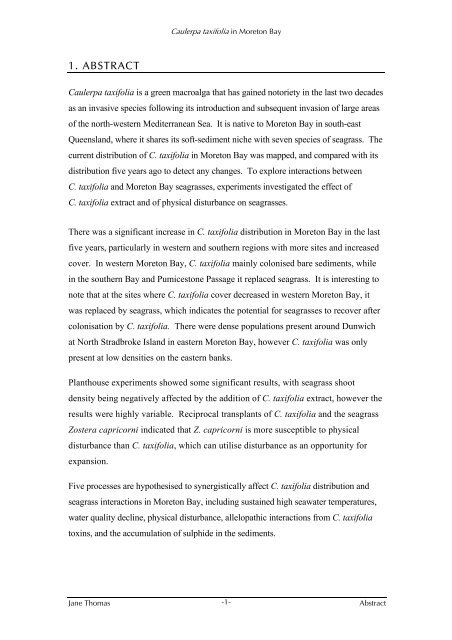caulerpa taxifolia in moreton bay - Centre for Marine Science ...
caulerpa taxifolia in moreton bay - Centre for Marine Science ...
caulerpa taxifolia in moreton bay - Centre for Marine Science ...
You also want an ePaper? Increase the reach of your titles
YUMPU automatically turns print PDFs into web optimized ePapers that Google loves.
1. ABSTRACT<br />
Caulerpa <strong>taxifolia</strong> <strong>in</strong> Moreton Bay<br />
Caulerpa <strong>taxifolia</strong> is a green macroalga that has ga<strong>in</strong>ed notoriety <strong>in</strong> the last two decades<br />
as an <strong>in</strong>vasive species follow<strong>in</strong>g its <strong>in</strong>troduction and subsequent <strong>in</strong>vasion of large areas<br />
of the north-western Mediterranean Sea. It is native to Moreton Bay <strong>in</strong> south-east<br />
Queensland, where it shares its soft-sediment niche with seven species of seagrass. The<br />
current distribution of C. <strong>taxifolia</strong> <strong>in</strong> Moreton Bay was mapped, and compared with its<br />
distribution five years ago to detect any changes. To explore <strong>in</strong>teractions between<br />
C. <strong>taxifolia</strong> and Moreton Bay seagrasses, experiments <strong>in</strong>vestigated the effect of<br />
C. <strong>taxifolia</strong> extract and of physical disturbance on seagrasses.<br />
There was a significant <strong>in</strong>crease <strong>in</strong> C. <strong>taxifolia</strong> distribution <strong>in</strong> Moreton Bay <strong>in</strong> the last<br />
five years, particularly <strong>in</strong> western and southern regions with more sites and <strong>in</strong>creased<br />
cover. In western Moreton Bay, C. <strong>taxifolia</strong> ma<strong>in</strong>ly colonised bare sediments, while<br />
<strong>in</strong> the southern Bay and Pumicestone Passage it replaced seagrass. It is <strong>in</strong>terest<strong>in</strong>g to<br />
note that at the sites where C. <strong>taxifolia</strong> cover decreased <strong>in</strong> western Moreton Bay, it<br />
was replaced by seagrass, which <strong>in</strong>dicates the potential <strong>for</strong> seagrasses to recover after<br />
colonisation by C. <strong>taxifolia</strong>. There were dense populations present around Dunwich<br />
at North Stradbroke Island <strong>in</strong> eastern Moreton Bay, however C. <strong>taxifolia</strong> was only<br />
present at low densities on the eastern banks.<br />
Planthouse experiments showed some significant results, with seagrass shoot<br />
density be<strong>in</strong>g negatively affected by the addition of C. <strong>taxifolia</strong> extract, however the<br />
results were highly variable. Reciprocal transplants of C. <strong>taxifolia</strong> and the seagrass<br />
Zostera capricorni <strong>in</strong>dicated that Z. capricorni is more susceptible to physical<br />
disturbance than C. <strong>taxifolia</strong>, which can utilise disturbance as an opportunity <strong>for</strong><br />
expansion.<br />
Five processes are hypothesised to synergistically affect C. <strong>taxifolia</strong> distribution and<br />
seagrass <strong>in</strong>teractions <strong>in</strong> Moreton Bay, <strong>in</strong>clud<strong>in</strong>g susta<strong>in</strong>ed high seawater temperatures,<br />
water quality decl<strong>in</strong>e, physical disturbance, allelopathic <strong>in</strong>teractions from C. <strong>taxifolia</strong><br />
tox<strong>in</strong>s, and the accumulation of sulphide <strong>in</strong> the sediments.<br />
Jane Thomas -1-<br />
Abstract


